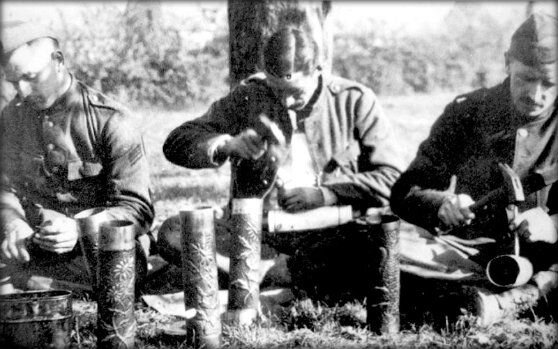'St. Mihiel' German 77mm Trench Art Artillery Shell







'St. Mihiel' German 77mm Trench Art Artillery Shell
Measures: 9 inches
Inscriptions: ‘St. Mihiel’
History of Trench Art:
During leisure hours at the front, skilled soldiers created trench art from the remnants of war such as discarded bullets and artillery shell casings. Many of these remnant of war were done with their own equipment and leftover items, but also by items captured and left by enemy soldiers. Trench art objects are holders of soldiers’ memories and reminders of the conflict they faced. Made out of recycled war refuse such as shell casings, spent bullets or whatever came to hand, they open a window to the past. They tell us things like where soldiers went and what their surroundings were like. They also give hints about soldiers’ thoughts and actions. Something as simple and functional as a matchbox cover can provide a map of a soldier’s movements while other, more decorative examples, show a desire to find and create beauty, to camouflage war in art. Trench art can be made of any number of things. Many objects were made out of the scraps created by war. This included ammunition shell cases, bullet casings, shrapnel, and pieces of destroyed buildings or downed planes. These materials would all have been readily available in the war zones to soldiers, their prisoners of war and to civilians still in the area.
77mm Cannon History:
The Germans placed a premium on mobility, which served them well during the early stages of World War I. However, once the front had become static, the greater rate of fire of the French gun and the heavier shells fired by the British gun put the Germans at a disadvantage. The Germans remedied this by developing the longer-ranged, but heavier 7.7 cm FK 16. The 7.7 cm Feldkanone 16 (7.7 cm FK 16) was a field gun used by Germany in World War I. The older 7.7 cm FK 96 n.A. field gun was very mobile, but, once the war settled into trench warfare, its lack of range became a serious disadvantage. The FK 16 was intended to remedy this problem. The barrel was lengthened and it was given a box carriage to allow for greater elevation, which increased the range. It was also given separate-loading ammunition to reduce powder consumption and barrel wear at short ranges, although this had the drawback of reducing the rate of fire compared to the older gun.
Battle of St. Mihiel:
Battle of Saint-Mihiel, (12–16 September 1918), Allied victory and the first U.S.-led offensive in World War I. The Allied attack against the Saint-Mihiel salient provided the Americans with an opportunity to use their forces on the Western Front en masse. Although lacking some of the tactical skills of the French and British, the U.S. First Army carried the day through sheer determination and its multifaceted plan of attack. The battle was also noteworthy as the first major use in the war of the U.S. Army Air Service (precursor to the U.S. Air Force) led by William "Billy" Mitchell and the aggressive tank assaults by George Patton, who boldly led his charges from the front lines and not from the rear as many other officers did during the war. As the Germans were withdrawing, the Allies attacked. With much of their artillery not in place, the Germans were poorly prepared to maintain the front line, an advantage that the attacking Americans were quick to exploit. The relative ease of the initial American attack came as a surprise to Pershing, and he sent orders to his commanders to speed up their advance. By the 13th September lead units of the U.S. First Army had met up with Allied troops advancing from the west. Three days later, the offensive was halted, with the salient in Allied hands. Pershing now dispatched his forces westward to take part in the forthcoming Meuse-Argonne offensive.